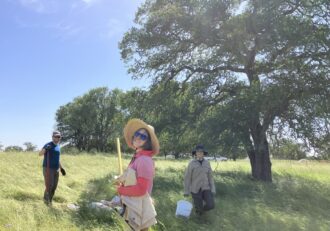Severe droughts, expected to increase due to climate change, pose threats to California’s rangelands. Ranchers and rangeland managers are facing decreased livestock forage production, reduced biodiversity, and soil degradation.
A previously funded Western SARE project (grant number OW19-349) found that compost amendments provide benefits to soils and forage productivity, including greater resilience to drought. However, there are potential limitations to applying compost amendments to rangeland soils, and research thus far has demonstrated mixed results, particularly for soil health. Key knowledge gaps remain for the soil microbiome; the community of microorganisms, such as fungi, bacteria, and viruses, which exist in a particular soil environment. Before implementing compost amendments on a large-scale basis, ecological affects and economic benefits/costs must be better understood.
University of California, Davis, graduate student Ava-Rose Beech expressed interest in various climate-smart ranching practices including compost soil amendments, so her adviser connected her with UC Cooperative Extension Farm Adviser Scott Oneto, who worked with compost application on the previously funded project. She is now collaborating with Oneto by using his field sites to assess how compost applications impact soil microbial abundance and soil microbial community composition and to investigate the potential of compost applications to improve resilience to drought on California rangelands.
“What is awesome about this project is the collaboration with partnering ranchers and Scott,” said Beech. “It provides an opportunity to use the same on-ranch sites and review my microbial data with his plant data. We’re all looking at practices that help drought resiliency and invasive species management through soil health building.”
Working on four separate ranches, Beech has taken a total of 96 sample soils. The four ranches selected were a subset of ranches included in Scott’s study. She chose the sites based on the differences in soil productivity, hopefully leading to a stronger understanding of how treatments impact microbial diversity in different soil types.
Speaking to ranchers’ interests, Beech says “All of the ranchers have been gracious about letting me take samples at their property. They’re interested the work, and I’m excited to share the data when it’s done.”
In addition to workshops, field days, and other outreach, Beech will be distributing surveys to determine rancher interest in and potential adoption of compost application practices and other climate-smart ranching techniques.
“Looking closely at climate smart practices, we must understand producers’ perspectives about how helpful these practices would be and if one or a combination of climate smart techniques could address their needs.”
All soil samples collected from the ranches have been analyzed. Data analysis from this project is ongoing. However, Oneto’s continued analysis of plant community composition has found that combined seeding and compost treatments did reduce invasive species cover. Based on previous work, Beech and her team anticipate that plots treated with combined compost and seeding, and with the greatest aboveground plant communities, will have more diverse below-ground microbial community composition.
Expressing her appreciation of the opportunity to work closely with ranchers, Beech says, “Getting this grant opened so many doors. It’s exciting to do field work on working ranches and work directly with the ranchers. I want to see what’s helpful to them, especially with the pressing issue of drought.”
